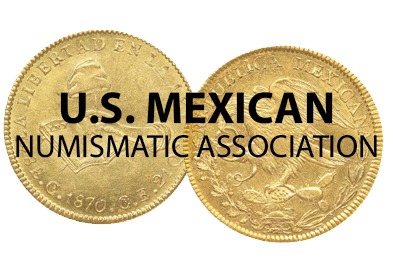Banco de la Laguna drawn on the Banco de Londres y México
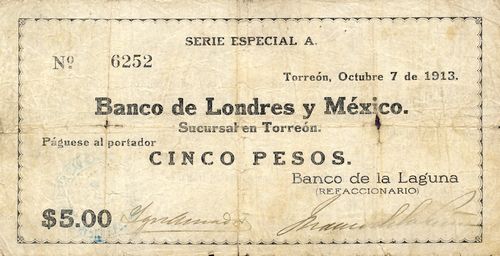
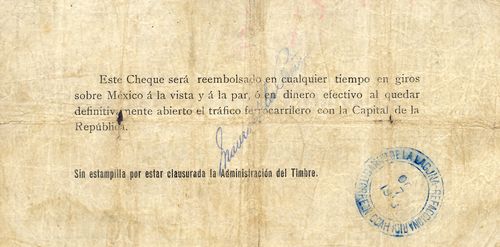 M1043a $5 Banco de la Laguna
M1043a $5 Banco de la Laguna
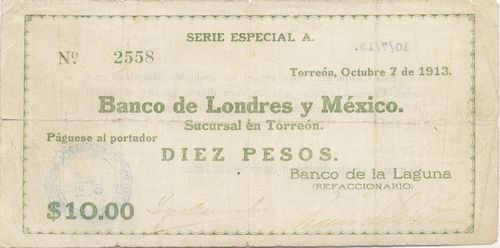
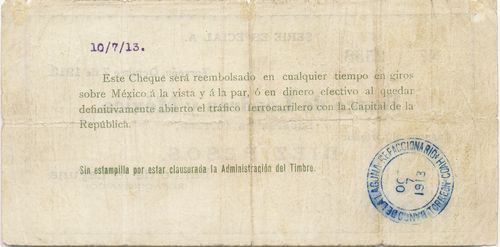 M1044a $10 Banco de la Laguna
M1044a $10 Banco de la Laguna
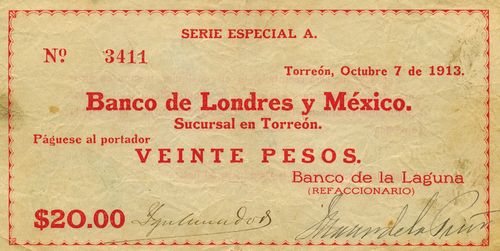
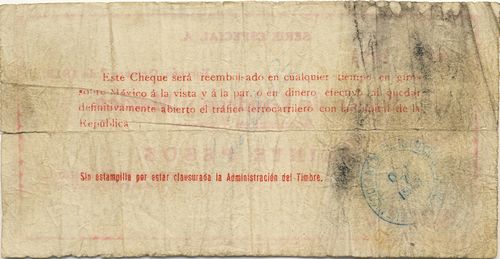 M1045a $20 Banco de la Laguna
M1045a $20 Banco de la Laguna
These are also known overprinted 'FALSO'.
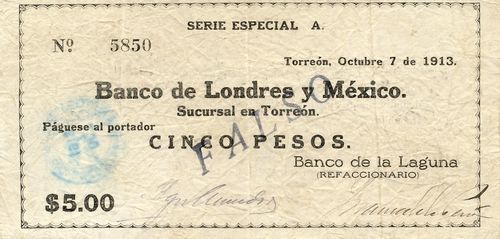
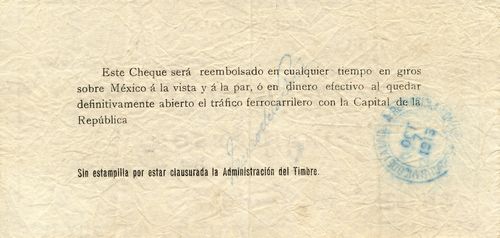 M1043b $5 Banco de la Laguna overprinted 'FALSO'
M1043b $5 Banco de la Laguna overprinted 'FALSO'
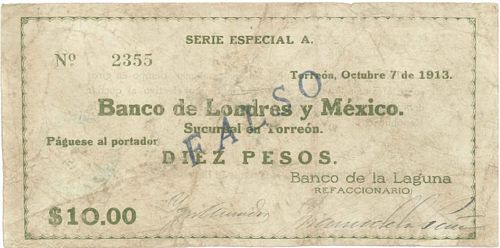
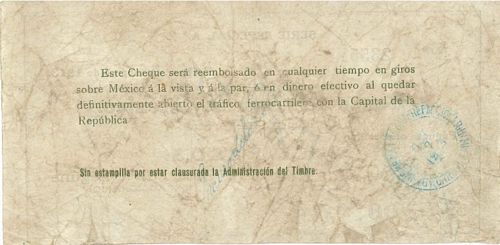 M1044b $10 Banco de la Laguna overprinted 'FALSO'
M1044b $10 Banco de la Laguna overprinted 'FALSO'
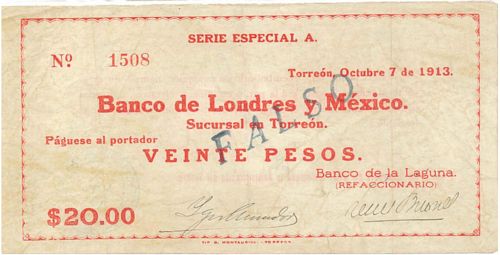
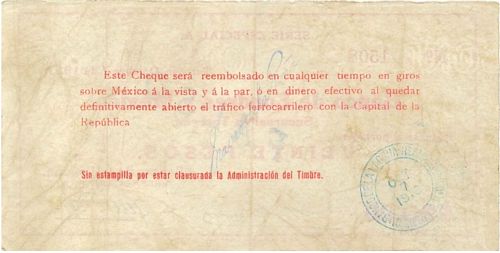 M1045b $20 Banco de la Laguna overprinted 'FALSO'
M1045b $20 Banco de la Laguna overprinted 'FALSO'
A report dated 31 August 1914AMS, fondo Presidencia Municipal, caja 157/1, legajo 34, exp. 7 gives the following details:
| Date on note | Denom | Series | from | to | total number |
total value |
|
| 7 October 1913 | $5 | A | 1 | 10000 | 10,000 | $50,000 | includes numbers 759 to 9576 |
| $10 | A | 1 | 3000 | 3,000 | 30,000 | includes numbers 2033 to 2917 | |
| includes numbers 3894 to 4854CNBanxico #10182 | |||||||
| $20 | A | 1 | 7000 | 1,000 | 20,000 | includes numbers 1308 to 3605 | |
| $100,000 |
According to a newspaper article thirty years later the Banco de la Laguna issued $100,000 in cheques drawn on the Banco de Londres y México but this proved insufficient and they resorted to issuing more. The same article later mentions $149,990El Siglo de Torreón, 11 October 1943.
The signatories are:
|
In 1908 Ignacio Amador was a vocal suplente of the Topia town councilAnuario Estadístico del Estado de Durango, 1908. |
 |
|
Mauro de la Peña Valdes was the son of Pragedis de la Peña and originally from Saltillo but moved to Torreón. He was formerly manager of La Fe cotton mills, was one of the managers of the model cotton plantation, El Pilar, near Sacramento, where the production of table grapes was studied, and was one of the founders of the great guayule industry in Mexico. He purchased the Cedros ranch for this purpose and later sold it to the Continental-Mexican rubber company. He was sub-gerente of the Banco de la Laguna from its establishment in 1907. He was a member of the ayuntamiento of Torreón in 1908El Tiempo, 5 January 1908 and 1909El Diario, 4 January 1909 and on 16 January 1911 was appointed Jefe Político for a period of four monthsEl Diario, vol. VI, núm. 1,529, 17 January 1911. In 1908-1909 he was treasurer of the Casino de la Laguna and in charge of constructing its new premisesThe Mexican Herald, 21 November 1909. |
 |
In June 1917 Lázaro de la Garza still had $10,000 in Banco de la Laguna bank-on-bank notesHe did not specify on which bank they were drawn. in the Rio Grande Bank & Trust and wanted to sell. He asked Raymundo Navarro who was in El Paso what was the best price he could getLG papers, 6-I-43, telegram L. de la Garza, Los Angeles, to Navarro, El Paso, 4 June 1917. Navarro replied that they were priced at 30c, but with no buyersLG papers, 6-I-45, telegram Navarro, El Paso to L. de la Garza, Los Angeles, 6 June 1917 though a few days earlier they had stood at 35cLG papers, 6-I-54, letter Navarro, El Paso to L. de la Garza, Los Angeles, 6 June 1917. De la Garza was still trying to sell them six months laterLG papers, 6-J-52, letter L. de la Garza, New York, to Navarro, El Paso, 21 December 1917. Navarro could not find a buyerLG papers, 6-J-53, telegram Navarro, El Paso to L. de la Garza, New York, 27 December 1917 but de la Garza found one in New York and the notes were sent to him there on 27 DecemberLG papers, 6-J-54, telegram de la Garza, New York, to Navarro, El Paso, 28 December 1917: 6-J-55, telegram. Navarro, El Paso, to L. de la Garza, New York. 28 December 1917.
Many of these notes are known as cancelled.
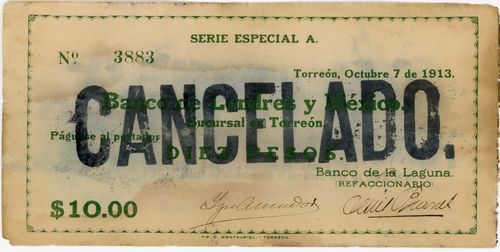 M1044d $10 Banco de la Laguna overprinted 'CANCELADO'
M1044d $10 Banco de la Laguna overprinted 'CANCELADO'
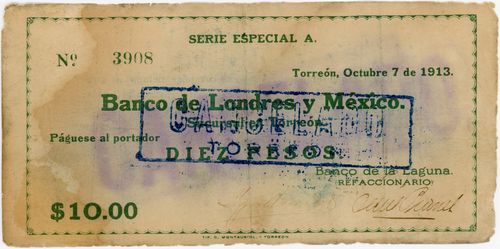
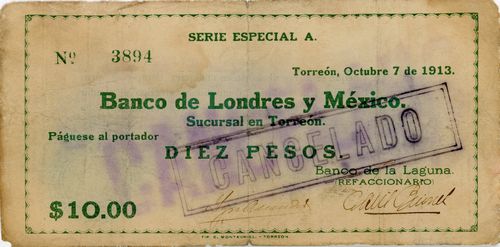 M1044c $10 Banco de la Laguna overprinted 'CANCELADO'
M1044c $10 Banco de la Laguna overprinted 'CANCELADO'
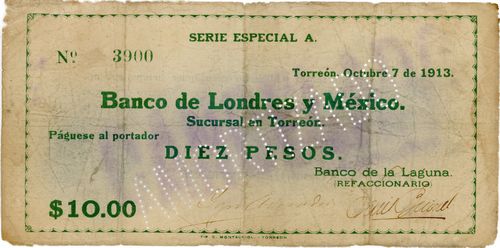
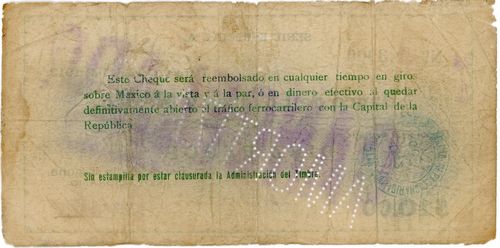 M1044e $10 Banco de la Laguna needle-punched 'AMORTIZADO'
M1044e $10 Banco de la Laguna needle-punched 'AMORTIZADO'
